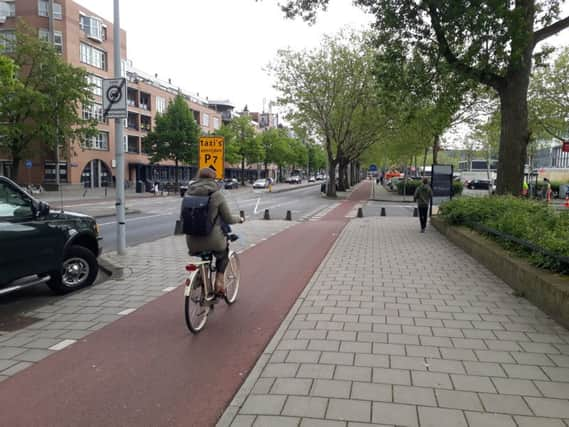Amsterdam-style cycling could transform Scotland – Alastair Dalton


Watching the locals cycle in Amsterdam on a visit this week was also an inspiring spectacle, being such a logical, natural and accessible way to travel. It is unsurprisingly the city’s favourite form of transport.
Taking up far less space than cars, yet seeming to make far better progress, those on two wheels also appeared to have the upper hand from my vantage point in a museum cafe.
Advertisement
Hide AdAdvertisement
Hide AdCyclists are not a different breed in Amsterdam. There are no helmets, high-visibility jackets or flashing lights. People ride in whatever they are wearing, such as smart suits, trailing overcoats and heels. Young children are strapped on, older ones just perch on the back.
Riders often have one hand on their coffee or phone, or clutch their shopping, with bigger items tied on behind them.
Segregated cycle lanes are commonplace on all but the narrowest streets, subtly differently coloured than vehicle lanes.
It struck me as looking like a separate road network, just for bikes – a world apart from a line of paint down the side of the street that is often the best we can do on many roads here.
On off-road sections, there are even pedestrian islands so walkers can cross safely between the bikes, there are so many.
This may seem a cycling paradise compared to Scottish cities, but it has been hard fought for. Tensions also remain, as I was to experience.
An exhibition at the Amsterdam City Archives, which runs until the end of June, highlights the battles cycle campaigners waged against the encroachment of the car in the 1960s and 70s, and for bikes to be given road space. It followed the widening of roads and the filling-in of canals to create more room for cars which just made congestion worse.
Cycling is now integral to Amsterdam’s transport system, which also boasts an impressively efficient and passenger-friendly network of trams, buses and trains.
Advertisement
Hide AdAdvertisement
Hide AdThere are 881,000 bikes in a city of 854,000 people, which collectively travel two million kilometres a day (1.2m miles) – or 50 times round the Earth.
But Amsterdammers are far from cycling in perfect harmony. The exhibition demonstrates that irritations are just as much an issue there as here – cyclists ignoring red lights, riding on pavements, using their phones, and not using lights at night.
One of the panels reads: “Some cyclists behave as if they always have priority. This behaviour gives rise to irritation between cyclists and other road users.”
I can certainly vouch for that, witnessing a cyclist and taxi driver almost coming to blows when the driver suddenly stopped on a narrow canalside street and the rider tried to squeeze past. It was worse than any such road rage incident I’ve seen on this side of the North Sea.
Scotland is becoming more of a cycling nation, even if it seems to be happening very slowly. More segregated lanes are being built, and there is an, often-hidden, network of off-road routes that make for even more pleasant pedalling, away from traffic noise, pollution and hazard.
On roads, a critical mass has yet to be reached. Then, the sheer volume of riders would make them sufficiently conspicuous to feel able to shed their fluorescent jackets and helmets – and help normalise cycling the way it is in cities like Amsterdam.